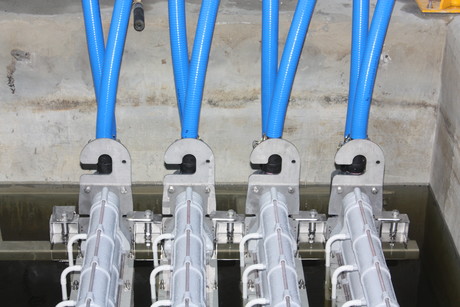Wastewater solution meets stringent regulations

A low-maintenance wastewater solution using Australian technology and membranes was implemented at the North Head Sewage Treatment Plant (STP). This has resulted in a number of benefits including: improved water conservation and energy efficiency, higher quality output, lower operation/maintenance costs and minimal environmental impact.
Being one of the largest wastewater treatment facilities in Sydney, the North Head STP uses a large amount of potable water in the various processes of the plant.
Drought across Australia prompted the increasing implementation of recycled water regulations. With these tightened regulations in 2005, the Sydney Water Corporation (SWC) sought a viable alternative to the STP’s water source. In addition to abiding by new restrictions, the plant’s location within a national park necessitated a solution that would have minimal impact on its surroundings, while still producing the required quality and quantity of water.
A membrane bioreactor (MBR) system from Evoqua was chosen for the recycled water plant due to its ability to provide consistent high-quality water, within a small footprint at lower capital and operating costs. Additionally, MBR technology allows a high sludge concentration and replaces clarification with membrane filtration and therefore requires relatively low maintenance with cleaning conducted while the membrane modules remain in the tank. The result has little impact on the surrounding environment.
The MBR system comprises separate aerated, anoxic and solids separation zones. Filtrate from the membrane zone is dosed with sodium hypochlorite to provide a chlorine contact time (CT) of at least 30 mg/L min. The membranes are hollow fibre with a 0.04μm nominal pore size. Screened settled sewage is pumped into the anoxic zone and mixed with a mixed liquor return. This combination then passes into the aerobic zone. Pumps draw from the aerobic zone and deliver mixed liquor to the membranes in the membrane operating systems (MOS).
Using the MBR system, the plant’s filtered water is drawn through membrane fibres by a suction pump to produce high-quality treated water. Simultaneously, the membranes are constantly scoured by an air/liquid mixture using MEMCOR® membrane bioreactor technology. Filtrate flows to chlorine contact tanks for disinfection before use in the treatment works, while mixed liquor recycles to the anoxic zone. Stable membrane performance is maintained by two types of routine cleaning. During weekly maintenance cleans, dilute hypochlorite is used as backwash. The three-monthly clean in place (CIP) is a much more rigorous cleaning process, involving removal of mixed liquor from the MOS, followed by washing.
In 2007, Sydney Water undertook a detailed study of the plant’s MBR system to determine its effectiveness in removing microorganisms. The results were log reduction values (LRV) in the range of 4.7 – 6.2 for F-specific RNA bacteriophage, 5.4 – 6.7 for E. coli and 3.7 – 5.2 for somatic coliphage.
The MBR also reduced Cryptosporidium, Giardia and human enteric viruses present in the influent to below detectable levels. These log reduction values exceeded most of the LRV range given for membrane filtration in the 2007 Australian Guidelines for Water Recycling (AGWR), despite being limited by the number of microorganisms present in the influent, proving that the MBR system is an effective and beneficial solution for pathogen removal, as well as high quality water output.
Advantages of the Evoqua MEMCOR® MBR system include:
- Smaller footprint and high water quality output
- Low maintenance system requirement
- System longevity and performance
- Long-term ability to meet regulatory criteria
- Environmentally sound investment
Evoqua Water Technologies has been leading the membrane industry for over 30 years and has had a dedicated MBR team since 1995. Our MBR technology is currently in operation in over 150 municipal and industrial plants worldwide and has been proven to deliver greater effluent and productivity at a reduced life-cycle cost. The company's global R&D and sole membrane manufacturing facility is located in Windsor, NSW.
Wannon Water Solves Pump Blockage Issue
Wannon Water replaced some old digester pumps at its Hamilton wastewater treatment plant with new...
Gippsland Water eliminates pump blockages at Morwell WWTP
At the Gippsland Water Morwell Waste Water Treatment Plant, the company have utilised two Gorman...
Sydney Water replaces actuators to ensure clean drinking water
Replacing hydraulic actuators with electric actuators from AUMA ensures drinking water is free...










